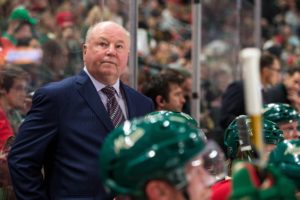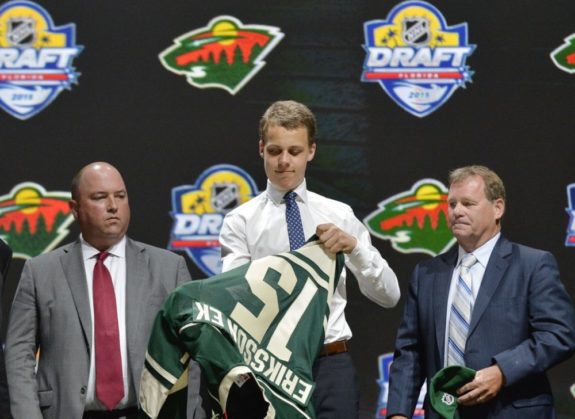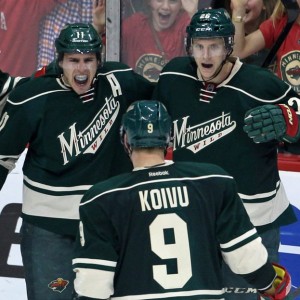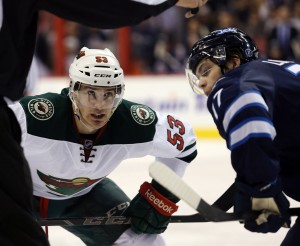Minnesota Wild prospect Joel Eriksson Ek got off to a hot start in his first season in North America and his play on the ice was making it seem like he was here to stay. The Swedish forward enjoyed some early success on the score sheet and appeared to be quickly eliminating all questions of whether or not he’d last in Minnesota past nine games.
Fast forward a few weeks later and the 19-year-old was questionably sent back to Farjestads BK, his home club in the Swedish Hockey League, but was it the right decision?
Early Play
The 6-foot-2 centre started his season off with visa problems which delayed his debut on North American ice as well as Minnesota’s eventual decision on where he would be playing out the majority of his 2016-17 campaign. Once his visa was in hand, Eriksson Ek was assigned to the American Hockey League’s Iowa Wild to get up to game speed.

The forward skated in one contest with Iowa in which he scored his first North American professional goal. The rookie was recalled shortly after and proceeded to score a goal in his first NHL game as well.
Building off the momentum of his early success, Eriksson Ek managed to record five points over his first four NHL games despite only logging an average time on ice of less than 10 and a half minutes. The youngster began earning high praise from coach Bruce Boudreau and he was seemingly well on his way to removing all doubt about his ability to stick on the NHL roster.
The centreman’s time on ice spiked with a career high 12:03 in his fifth game before dipping back down to his season average in games six through nine. Over the course of his last five games in the NHL, Eriksson Ek went pointless and was only 25% on the draw.
While a five-game dry spell was definitely disappointing following his impressive start to the season, it should have come as no surprise considering the circumstances. It’s important to remember that this is a 19-year-old hockey player who has never offensively dominated any professional league in the past. Sure, he set the bar high with a strong handful of games to open his NHL career but it would have been unwise for anyone to expect him to maintain such a high scoring pace through an extended stretch of games.
Unfortunately for Eriksson Ek, he just happened to encounter his first scoring drought right when his general manager had to make a decision on his immediate playing future.
A look at the Eriksson Ek move, Swedish duo of @ChristianFolin & @brodin25 & #COLvsMIN → https://t.co/dQc1zcJxYS pic.twitter.com/o3xsraNDk2
— Minnesota Wild (@mnwild) November 18, 2016
As his ice time plateaued, there were whispers that a decision was looming and that the Swede could be heading home. The Wild were getting healthier up front and Eriksson Ek was being used sparingly in a fourth line role with little to no power play time.
The ever important ninth game was fast approaching and it would be Eriksson Ek’s last chance to show, without question, that he belonged on the big stage before his entry-level contract was due to kick in. His final audition was cut short, however, as Eriksson Ek took a puck to the face and was forced to leave his final game due to injury after only six minutes of ice time.
A decision on Eriksson Ek’s future wasn’t immediately made as the Wild’s management group mulled over what to do with their prized rookie. They wanted to do what they felt would be best for both the team and the player.
The choices were to keep the 19-year-old on the roster and allow him to play past his ninth game which would result in his entry-level contract coming into effect, to send him back down to Iowa where he could continue to learn the game on the smaller ice surface and be available for recall at a moment’s notice, or to loan him to a professional league overseas where he would then become ineligible to return to Minnesota’s lineup until the conclusion of his European team’s season.
After weighing the pros and cons over a handful of days, general manager Chuck Fletcher and company ultimately decided to loan Eriksson Ek back to Farjestad of the SHL where he has played the previous two seasons and will now play out the remainder of the 2016-17 season.
Implications for Eriksson Ek
If he wasn’t going to be playing in the NHL this season, Eriksson Ek’s first choice was allegedly to return to Sweden. Not only has Eriksson Ek played for Farjestad in the SHL for the past two seasons but he played his youth hockey in Farjestad’s system as well.

The loan to the SHL brings Eriksson Ek back to a place he is very familiar and comfortable with. We tend to forget that young players are young people too and being comfortable with their surroundings is often something that is overlooked but can be crucial to their development.
In Farjestad, Eriksson Ek will not be a rookie but will be a third-year pro. He should be in line to receive prime minutes and he’s expected to see time in all situations for his team. Gaining experience in special teams duties could go a long way to helping the centre eventually play in similar situations for Minnesota in the years to come.
In addition to an expanded role on his SHL team, Eriksson Ek should also play a vital role for Team Sweden at this year’s world juniors. More of a secondary player on the team one season ago, the Wild prospect should be a feature player this time around and nothing seems to boost a prospect’s stock more than a solid performance on the international under-20 stage in December.
The little experience that Eriksson Ek did receive in North America should also prove to be beneficial for him moving forward. He shouldn’t encounter as much of a culture shock next season after now having spent some time in the United States and the importance of his familiarity with Boudreau and the rest of the coaching staff should not be understated.
Eriksson Ek can expect to be in constant contact with Minnesota’s player development staff as they will be following his progress closely throughout the year. The assignment to the SHL also buys the youngster some time to bulk up with the goal of coming to the Wild’s training camp next season with a fuller and sturdier frame.
Implications for the Wild
Minnesota made Eriksson Ek their first pick in 2015 when they selected him 20th overall ahead of the likes of Colin White, Ilya Samsonov, Brock Boeser, and Travis Konecny. It’s fair to say that the youngster is a key piece for the Wild moving forward and the team wants to ensure that they do what they feel is best for both the player and the team in the long term.
After seeing the rookie play in his first nine NHL games, there’s no question in my mind that he has the talent and smarts to play in the league today. The concern, however, was that he might not get a chance to further develop the skills that could make him a future impact player if he stuck around in Minnesota while being given minimal ice time.

The Wild are a veteran-laden team and are currently playing to win. They don’t necessarily have the luxury to try out a 19-year-old rookie on their scoring lines during regular season play with the hopes that he takes off. The team’s current top six is jammed full of more experienced and proven scorers at the NHL level and it’s easy to forget that Zach Parise, Eric Staal, Charlie Coyle, Nino Niederreiter, Mikko Koivu, and Mikael Granlund are all former first-round picks themselves.
Eriksson Ek was very impressive with his positioning and on-ice awareness in all three zones during his brief nine-game trial with Minnesota. The rookie showed that he could keep up but, had the Wild kept him in the lineup playing strictly third and fourth line minutes with no special teams duty, they would have risked the possibility of him becoming complacent in the role and perhaps not developing into anything more than a glorified defensively-responsible bottom-six forward. The last thing that Boudreau and the Wild want to do is stagnate the development of arguably the team’s top prospect and have him lose some of the skills that made him such a high draft selection in the first place.
Minnesota delayed the clock on the rookie’s entry-level deal and freed up a contract spot on their 50-man list at the same time when they loaned the Swede back to the SHL for the remainder of the season. This decision could prove to be extremely beneficial to the Wild moving forward as, not only do they now have Eriksson Ek locked into a low cap hit for the next three years, but they also find themselves with some newly added flexibility in terms of roster movement for this season.
The Wild had been sitting at 49/50 contract spots occupied but are now at 48 with Eriksson Ek’s contract sliding to next season. This means the team might not be as hesitant to grab someone off waivers or to take an extra contract back in order to sweeten a trade return.
The right call?
The Wild wanted to do what was best for the player and the team. The argument is that Minnesota would be better today with Eriksson Ek playing on their fourth line ahead of Tyler Graovac, Zack Mitchell, or Zac Dalpe but there’s also the argument that the team will benefit from getting a more physically mature and offensively confident player back for the 2017-18 season.
The Wild will have some contract juggling to do during the offseason and they might be in tough to bring back all of their key restricted free agents. The window of opportunity could be wide open for someone like Eriksson Ek to settle into a regular top-six role should one become vacant.
The biggest question for me is why not assign Eriksson Ek to the AHL where he would continue to develop his skills while being deployed in all situations under close watch from the Wild staff?

The entry-level contract would still slide if he played out the season on the AHL roster and he would have had plenty of opportunity to become more familiarized with the smaller ice surface as opposed to readjusting to the larger one he’s currently playing on again in Sweden. This is not an untraveled road as the Colorado Avalanche’s Mikko Rantanan and the Toronto Maple Leafs’ William Nylander both played in the AHL as underage forwards in 2015-16 and seem to have benefited from the experience.
Playing AHL hockey would not have meant missing out on the world juniors either, as Eriksson Ek could have taken leave from Iowa to play for Sweden in December and January just as both Rantanan and Nylander did a season ago.
Maybe the biggest benefit of having Eriksson Ek in the AHL would have been his availability for recall at a moment’s notice if injuries or poor play were affecting Minnesota’s forward group. Since Eriksson Ek is now on loan to the SHL, he’s ineligible to play another game for Minnesota until Farjestad’s season is over. This situation is not unlike assigning a junior-aged player back to the Canadian Hockey League. Take the Arizona Coyotes and Dylan Strome for example.
In the end, Fletcher and the management team opted for the SHL option. It’s not known for sure, but the decision may have been out of respect to the player himself who was heavily rumoured to have a strong preference of playing another season in Sweden. Whatever the case may be, the decision has been made and there’s no changing it now.
Although I strongly believe the AHL would have been the best choice for Eriksson Ek’s development, I expect him to make an impact with his SHL team this season, play a prominent role for Sweden at the world juniors, and be wearing his number 14 jersey in Minnesota’s opening night lineup come next October.